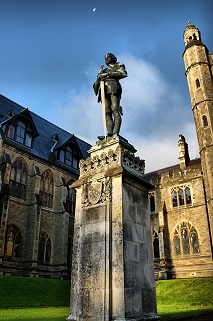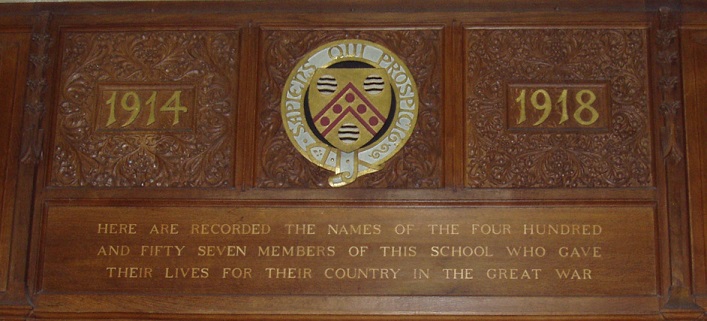



The following is a list with biographies of the 462 people who attended Malvern College and died due to the First World War. Altogether 2,833 are known to have served. There is also a corresponding page commemorating the 249 casualties in the Second World War.
There was not a month from August 1914 to November 1918 that an Old Malvernian did not become a casualty, with 6 killed on the first day of the Battle of Loos on the 25th September 1915 and 13 killed on the first day of the Battle of the Somme on the 1st July 1916.
The vast majority of casualties occurred in France and Belgium with 31 names recorded on the Menin Gate at Ypres, and 23 at Thiepval. There were also 23 casualties in Turkey due to the Gallipoli Campaign, and 16 in Iraq, including 2 near Kut.
They were in a wide range of regiments including 26 in the Royal Field Artillery, 13 in the Royal Engineers, 12 in the Worcestershire Regt, 11 in the Canadian Inf, 11 in the East Kent Regt (The Buffs), and 5 in the Royal Flying Corps and the Royal Air Force.
Most were officers with 133 Captains, 126 2nd Lieutenants, 114 Lieutenants, 26 Majors, and 15 Lieutenant Colonels.
29 received the MC, 10 the DSO and 1 the DCM, as well as 3 knighthoods (the CB, CMG, and MVO).
The information below is based primarily on the memorial books held at Malvern College which Ian Quickfall, and now Paul Godsland, the Malvernian Society archivists, have arranged to be digitised with the official memorial web site still in development.
Further information was also obtained from 'The Malvern College Register 1865-1924' edited by H.G.C Salmon, 'The Malvernian' school magazine, 'A History of Malvern College 1865 to 1965' by Ralph Blumenau, and 'Malvern College: A 150th Anniversary Portrait' by Roy Allen.
Information was also obtained from the Commonwealth War Graves Commission website, the Unit War Diaries and Service Records held at the National Archives in Kew, and various online commemorative websites whose links have been provided.
The main battles have tried to be identified in which Old Malvernians died in. Many though were killed in the general attrition of Trench Warfare which is so vividly described in the book 'Nothing of Importance' by Bernard Adams.
Below is a map showing the locations of the 246 cemeteries where Old Malvernians are buried or commemorated in. The markers are coloured yellow for one casualty, orange for between 2 and 9, and red for 10 or more. The name of the cemetery and number of casualties can be seen by hovering over the marker, and the list of names seen by clicking on the marker. Their full biographies and pictures can be seen by clicking on 'Further Info'.
The records can be filtered and/or sorted by name, house, age, regiment, battle, date, place etc by clicking on the appropriate drop down box and then the 'Search' button below the map. The original memorial book entry can be seen by clicking on the person's picture.
Son of Michael and Frederica Longridge, Linkvretten, Bowdon. b. 1875.
Upper IV—Army Class. Minor Scholar. School Prefect. Shoot
ing VIII; XXII Football; House XI Cricket. Lieutenant in Corps.
R.M.C. Sandhurst; passed out 2nd; West Surrey Regt. 1895;
Indian Army 1897; Major 1913; Assistant Secretary Imperial
Defence Committee; China 1900, Despatches, Medal; Somaliland,
1903-04, Despatches, Medal with 2 Clasps.
Great War, G.S.O. Indian
Expeditionary Force, C.M.G .(Companion of St Michael & St George)., Brevet Lieut.-Colon.
Husband of Alice Lilian Longridge, of Bow Cot, Headley, Hants.
'In September 1914 he gave up his appointments at home to join the Army in France on the Staff of the Indian contingent. In 1915 he was transferred to become Chief Staff Officer of a Division. On August 18th, 1916, he stayed on in the trenches with characteristic thoroughness, to observe some operations which he had directed, and was hit by a stray bullet. He died instantaneously. The brief record which is given above of Colonel Longridge's twenty-one years' service is sufficient to show that in him the School has lost one of her most distinguished soldier sons. That, if merit met with due reward, he would reach a high position in the Army, was confidently predicted by those who had, in his youth, observed his outstanding qualities of mind and character. He impressed men by his quiet strength and steadfast purpose, his acute and penetrating intellect, his unwearied devotion to duty, his courtesy and charm of manner. Some idea of the estimate formed of him in high places is given by the following extracts from letters written by Generals and public men under whom and with whom he served.
"He was an exceptional man and a splendid staff officer. His division and all who knew him respected him greatly."
"To the Indian Corps he was invaluable. . . . He seemed assured of a career of great distinction. We can ill spare men of his worth."
"In him the Service has lost one of its most distinguished officers."
"His ability, his indefatigable love of work, and his devotion to his profession and scientific equipment for it, marked him out, had he been spared, for high eminence."
"The country has lost one of the very best officers we had. . . His grasp of broad principles was only excelled by his extraordinary mastery of detail. . . . His was a splendid character, including courage of the highest order, ceaseless perseverance, tact, and great ability."
We are authorised by Lieut.-Colonel Sir Maurice Hankey, K.C.B., Secretary of the Committee of Imperial Defence, to state that, in the years preceding the war, Colonel Longridge did invaluable work in connection with the arrangements for the preparation for war. The value of Colonel Longridge's work in this respect was fully recognised by the Prime Minister and the Committee of Imperial Defence, and was rewarded with a C.M.G. Nowhere is Colonel Longridge's death more deeply felt than in the Committee of Imperial Defence and among his colleagues in the Secretariat, who not only placed the highest value on his professional attainments, but were united to him by bonds of intimate friendship.' (Malvernian, Dec 1916).